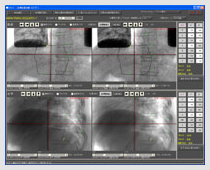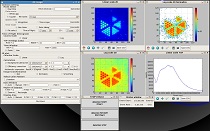Our socutions
Our applications
EmerSim® is our original cloud based, emergency care training system for doctors, nurses, midwives, and medical staffs.

- EmerSim® for on-site or remote training
- EmerSim® is a vital signs monitor simulator for emergency care training, which is widely used by doctors, nurses, midwives, and medical staffs in Japan.
- Learn more about EmerSim® in promotion page promotion page
Our solutions
We develop and deploy data processing systems designed to support a wide variety of scientific experiments, simulations, analysis and visualization.

- Development of a software system to support high radiation medical treatment, including on-site support where the treatment is delivered.
-
We have developed software for treatment sites which employ the highly advanced medical technology performed by the National Institute of Radiological Sciences(NIRS), headquartered in Chiba City, Japan. We created software, used on-site, that helps doctors at the NIRS precisely administer treatments that utilize heavy ion radiotherapy, a cancer-fighting technique developed by the institute.
When it comes to administering radiation to patients, two of the most important factors for all techniques, including heavy ion radiotherapy, are "how much" to give and "where" on the patient it should be administered. The software developed at Penguin System helps doctors decide the "where" part of the equation. *Left picture
Since the patient is never in the exact same position twice, doctors must constantly adjust where they aim the radiation. This is where our software steps in, rather than having the hospital staff manually adjust where the treatment is performed each time, a tedious and potentially error-prone process, the software we developed examines the patients x-rays and automatically corrects for any changes in the patient's posture or position. It does this by comparing the current x-rays with ones taken previously and measures both the horizontal and vertical changes. It then presents these changes to the medical team, allowing them to adjust the equipment accordingly.
Support for researchers investigating irradiation therapy
Through our tools, we are supporting researchers of heavy ion radiation therapy make even more cutting edge breakthroughs in the field.
We are able to gather the researcher's needs and quickly turn around and deliver a tool that meets those needs, freeing the researcher to focus to their research.

- Software development for a new type of detector for both neutrons and hard X-rays
-
In October 2009, Penguin System and KEK signed a joint research contract to develop software to analyze and visualize data collected by quantum beam detectors. This project has been designed to work with the remarkable quantum beam detector (for which a patent has already been granted) developed by Professor Shoji Uno of KEK-IPNS. Our goal in creating this software was to create a product that can be widely deployed in many different civilian applications.
This new detector's strong points are its wavelength sensitivity and it's spatial and temporal resolution. Unlike other sensors, this new detector is able to sense multiple wavelengths of various ionizing radiation such as neutrons, X-rays, and hard X-rays. In addition the detector's spatial and time resolutions are much higher than that of conventional detectors, allowing them to penetrate through thick substances that those detectors cannot. Furthermore, the new detector uses standard Ethernet, allowing it to communicate easily with PCs.
In order to quickly process, analyze, and visualize the output, software that is fast enough to keep up with the massive amount of data being outputted by the detector is essential. Such software is not easy to create, but we were able to meet the challenge.
We are also making adjustments to improve the accuracy of the sensors as well as how the data is presented to the users. We are hoping that these alterations will make the sensors more practical for use in a wide variety of civilian applications.
Towards a new type of detector and more practical software
The core parts of this new type of detector were developed by Shoji Uno, Professor at KEK and member of the Detector Technology Product group, took the lead in developing this technology.
Professor Uno says "Penguin System's contributions towards our joint research were both flexible and positive. I would definitely like to work together again to further develop hardware/software solutions for the detector." Our detector and software combination is able to do things that conventional systems cannot, such as display measurements on a PC in real time. Our system's main advantage is it's ability to detect ionizing radiation in place, on the PC, and cheaply.
In cooperation with KEK, we are currently planning on evaluating the use of this new sensor for various civilian applications, such as non-destructive inspection, radiation therapy, and material science research.
